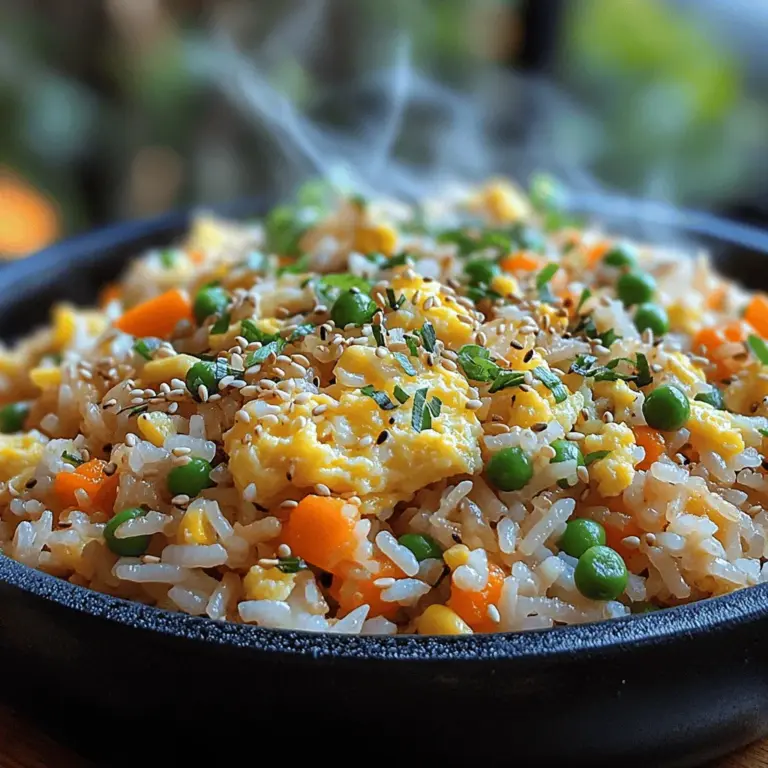Introduction
Hibachi Fried Rice is a beloved dish that has captured the hearts and palates of food enthusiasts across the globe. Originating from Japanese cuisine, this flavorful rice dish is often prepared in restaurants featuring hibachi grills, where chefs skillfully entertain diners with their culinary prowess. The combination of perfectly cooked rice, fresh vegetables, and savory sauces creates a dish that is not only delicious but also visually appealing, making it a staple in both casual and fine dining settings.
One of the secrets to achieving the perfect Hibachi Fried Rice lies in the rice itself. For the best texture and flavor, it is crucial to use day-old rice. Freshly cooked rice tends to be too moist and sticky, which can lead to clumpy fried rice. By allowing the rice to cool and dry out in the refrigerator overnight, the grains firm up, making them easier to separate during cooking. This technique is essential for achieving that coveted restaurant-quality fried rice at home.
Another appealing aspect of Hibachi Fried Rice is its versatility. While the core ingredients remain the same, you can customize the dish to suit your preferences by adding a variety of proteins. Whether you choose chicken, shrimp, steak, or even tofu for a vegetarian option, Hibachi Fried Rice can easily cater to different tastes and dietary requirements. This adaptability makes it a perfect dish for family gatherings, meal prep, or simply a weeknight dinner.
Understanding Hibachi Cooking
To fully appreciate Hibachi Fried Rice, it’s important to understand the hibachi cooking style and its cultural significance. The term “hibachi” refers to a traditional Japanese heating device, typically a small, open grill that uses charcoal as a heat source. However, in the context of dining and culinary experiences, hibachi often refers to the style of cooking performed by skilled chefs at teppanyaki grills, where food is prepared on a flat iron griddle in front of guests.
Teppanyaki cooking, a method that originated in Japan, is characterized by the use of a wide, flat surface for grilling various ingredients. Chefs not only cook but also perform entertaining tricks, showcasing their knife skills and flair for presentation. While hibachi and teppanyaki are often used interchangeably, it is essential to note that true hibachi refers to the grill itself, whereas teppanyaki is more focused on the cooking technique.
Hibachi Fried Rice fits seamlessly into the broader context of Japanese cuisine and dining culture. The dish often accompanies grilled meats and seafood, making it a popular choice in hibachi restaurants. It reflects the Japanese emphasis on fresh, high-quality ingredients, and the art of presentation. Moreover, sharing a meal cooked right before your eyes adds to the communal and festive experience of dining, fostering connections among family and friends.
Ingredients Overview
Creating the perfect Hibachi Fried Rice requires a selection of quality ingredients, each playing a vital role in the dish’s flavor and texture. Let’s explore the essential components of this delightful recipe.
Jasmine Rice
The foundation of any fried rice dish is the rice itself, and in the case of Hibachi Fried Rice, jasmine rice is the preferred choice. This long-grain variety is known for its fragrant aroma and slightly sticky texture, which makes it ideal for frying. However, the key to achieving that perfect texture lies in using day-old jasmine rice. When cooked and refrigerated overnight, the rice grains firm up, making them less likely to clump together during the frying process. This results in a light and fluffy fried rice that allows each grain to shine.
Oils
The choice of oil can significantly impact the flavor of your Hibachi Fried Rice. Typically, vegetable oil is used due to its high smoke point, which is essential for stir-frying at high temperatures. Vegetable oil provides a neutral flavor that allows the other ingredients to stand out. On the other hand, sesame oil is often added for its rich, nutty flavor. It is best used sparingly, as a little goes a long way. The combination of these oils helps create a beautifully sautéed dish that bursts with flavor.
Eggs
Eggs are a staple ingredient in Hibachi Fried Rice, contributing both nutritional value and flavor enhancement. They are packed with protein and healthy fats, making the dish more satisfying and balanced. The eggs are typically scrambled and then mixed into the rice, adding a creamy texture and richness. Mastering the technique of scrambling eggs properly, ensuring they are cooked just right, is crucial for elevating the overall dish.
Mixed Vegetables
Color and nutrition are essential in creating a well-rounded Hibachi Fried Rice. Mixed vegetables, such as peas, carrots, and bell peppers, not only add vibrant hues but also provide essential vitamins and minerals. These vegetables contribute texture and sweetness, balancing the savory flavors of the rice and sauces. Feel free to customize the vegetable mix according to your preferences or seasonal availability, ensuring a dish that is both delicious and nutritious.
Aromatics
Aromatics like garlic and ginger play a pivotal role in developing the flavor profile of Hibachi Fried Rice. These ingredients add depth and complexity, elevating the dish from simple fried rice to a fragrant and savory delight. Garlic infuses the dish with its distinctive aroma, while ginger adds a slightly spicy kick that complements the other ingredients beautifully. Sauteing these aromatics at the beginning of the cooking process releases their essential oils, enhancing the overall flavor of the dish.
Sauces
The sauces used in Hibachi Fried Rice are fundamental in tying all the flavors together. Soy sauce is a classic choice, providing a salty, umami flavor that is synonymous with Asian cuisine. It is typically added during the frying process, allowing the rice to absorb its rich taste. Teriyaki sauce can also be used for a touch of sweetness and additional depth. Understanding the balance between these sauces is key to achieving a harmonious flavor profile in your fried rice.
Optional Proteins
Finally, one of the most appealing aspects of Hibachi Fried Rice is the ability to customize it with various proteins. Whether you decide to add chicken, shrimp, steak, or even tofu, each protein brings its unique flavors and textures to the dish. Chicken is a popular choice due to its mild flavor and versatility, while shrimp adds a touch of sweetness and elegance. Steak, on the other hand, provides a hearty and robust flavor that pairs excellently with the rice. Choosing the right protein not only enhances the dish’s taste but also boosts its nutritional value.
Preparation Steps for Hibachi Fried Rice
Now that we’ve covered the ingredients, it’s time to dive into the preparation steps for making delicious Hibachi Fried Rice. This step-by-step guide will ensure you create a restaurant-quality dish right in your own kitchen.
Step 1: Preparing the Rice
If you’re using day-old jasmine rice, ensure it is fully chilled and stored in an airtight container in the refrigerator overnight. If you need to cook fresh rice, rinse 1 cup of jasmine rice under cold water until the water runs clear. This removes excess starch and prevents the rice from becoming too sticky. Cook the rice according to package instructions, then spread it out on a baking sheet to cool. Allow it to sit for at least 30 minutes before using.
Step 2: Scrambling the Eggs
In a large skillet or wok, heat a tablespoon of vegetable oil over medium-high heat. Crack two eggs into a bowl and whisk them until well combined. Pour the eggs into the hot skillet, swirling them around to create a thin layer. Allow the eggs to cook undisturbed for about 30 seconds or until they begin to set. Using a spatula, gently scramble the eggs, breaking them into smaller pieces as they finish cooking. Once fully cooked, transfer the scrambled eggs to a plate and set aside.
Step 3: Sautéing Aromatics
In the same skillet, add another tablespoon of vegetable oil. Once the oil is hot, add minced garlic (about 2 cloves) and grated ginger (1 teaspoon). Sauté the aromatics for about 30 seconds, stirring constantly to prevent burning. This step is crucial, as it releases the flavors of the garlic and ginger, infusing the oil and forming the flavor base for your fried rice.
Step 4: Adding Vegetables
Next, add a mix of your chosen vegetables to the skillet. A combination of peas, diced carrots, and bell peppers works beautifully, but feel free to get creative with your vegetable selection. Stir-fry the vegetables for about 2-3 minutes or until they are tender but still crisp. This step adds vibrant color and essential nutrients to your dish, enhancing both its appearance and flavor.
Step 5: Incorporating the Rice
Now it’s time to add the day-old rice to the skillet. Use a spatula to break up any clumps, ensuring the rice is loose and separated. Pour in the soy sauce (about 2-3 tablespoons), adjusting to taste, and stir to evenly coat the rice and vegetables. The rice should begin to take on a beautiful color while absorbing the flavors of the soy sauce and aromatics.
Step 6: Mixing in the Eggs
Finally, return the scrambled eggs to the skillet, mixing them into the rice and vegetable mixture. Stir everything together for another minute, allowing the flavors to meld and the dish to heat through. Taste the fried rice and adjust the seasoning if needed, adding a splash of teriyaki sauce for sweetness if desired.
With these steps, you are well on your way to creating delicious Hibachi Fried Rice that can impress family and friends alike. Remember, the key to a successful fried rice lies in the quality of your ingredients and your attention to detail during the cooking process. Enjoy the journey of making this delightful dish, and get ready to savor the vibrant flavors of Hibachi Fried Rice!
{{image_1}}
Stir-frying Mixed Vegetables and Optional Proteins for Texture
To achieve the quintessential taste of Hibachi Fried Rice, the stir-frying process is critical. Start by heating your wok or a large skillet over medium-high heat. Once the pan is hot, add a tablespoon of vegetable oil. This oil not only prevents sticking but also helps to impart a delicious flavor to the dish.
Next, toss in your selected mixed vegetables. Common choices include peas, carrots, bell peppers, and onions. These vegetables not only add vibrant color but also contribute essential nutrients to your meal. Stir-fry the vegetables for about 3-4 minutes, until they are tender yet still crisp.
If you’re adding proteins, such as diced chicken, shrimp, or tofu, now is the time to incorporate them. Cook the proteins alongside the vegetables until they are fully cooked through. Stir-frying at high heat ensures that the proteins develop a nice sear while keeping them juicy. The combination of crispy vegetables and succulent proteins provides a delightful texture that elevates the entire dish.
Combining Ingredients for Even Distribution of Flavors
Once your vegetables and proteins are cooked, it’s time to introduce the rice. Make sure your rice is day-old and cold, as this will help it separate easily while cooking. If you’re using freshly cooked rice, spread it out on a tray and let it cool to prevent clumping.
Add the rice to the vegetable and protein mixture. As you stir, use a wooden spatula to break up any clumps, ensuring even distribution. Pour in your seasonings, including soy sauce and teriyaki sauce, ensuring every grain of rice is coated. The key is to toss everything together rather than stirring too vigorously, which can lead to a mushy consistency.
Cooking Techniques
The Importance of Heat Levels in Stir-frying
Heat is a crucial factor in stir-frying. The aim is to create a quick, high-temperature cooking environment that allows the ingredients to cook rapidly without steaming. Using a high heat will give your Hibachi Fried Rice that authentic “wok hei” or “breath of the wok” flavor, which is essential for the dish’s authenticity.
If the heat is too low, the ingredients will steam rather than fry, resulting in a soggy dish. Conversely, if the heat is too high, you might burn the ingredients. For best results, keep your stove on high and make sure not to overcrowd the pan; this allows the heat to circulate freely.
Tips for Achieving the Perfect Texture in Fried Rice
To achieve the perfect texture in your Hibachi Fried Rice, consider these tips:
1. Use Day-Old Rice: Freshly cooked rice is often too moist and can lead to clumps. Make your rice a day in advance and refrigerate it to dry out.
2. Avoid Overcooking: Stir-fry quickly. Prolonged cooking can lead to mushy rice and overcooked vegetables.
3. Don’t Skip the Oil: Proper oiling makes a difference by allowing for that non-stick finish and helps in achieving a slight crispiness to the rice.
Explanation of How to Prevent Rice from Becoming Mushy
Preventing mushy rice is essential for creating an enjoyable Hibachi Fried Rice experience. Here are a few strategies:
– Rinse Your Rice: Before cooking your rice, rinse it under cold water until the water runs clear. This removes excess starch, which can make the rice gummy.
– Steam, Don’t Boil: If cooking fresh rice, use a method that steams rather than boils it to help maintain the grains’ integrity.
– Cool Before Storing: If you’re preparing rice ahead of time, let it cool completely before refrigerating it. This cooling process helps to firm up the grains.
Flavor Enhancements
Importance of Seasoning and Balancing Flavors
Seasoning is pivotal in bringing Hibachi Fried Rice to life. A well-seasoned dish will have layers of flavor that complement each other. Start with a base of soy sauce, which adds umami and saltiness. Adjust according to your taste; if you prefer a sweeter flavor profile, add a splash of teriyaki sauce.
How to Adjust Soy Sauce and Teriyaki Sauce for Personal Taste
The beauty of Hibachi Fried Rice lies in its adaptability. Some may prefer a saltier dish while others might like a more subtle flavor. Start with 2 tablespoons of soy sauce, and taste as you go. If you desire more sweetness, incorporate a bit of teriyaki sauce, which naturally balances the saltiness of the soy sauce.
Suggestions for Additional Flavors
To enhance the flavor further, consider adding:
– Chili Oil: For a spicy kick, drizzle in some chili oil towards the end of cooking.
– Lime Juice: A squeeze of fresh lime juice can brighten the dish and add a refreshing zing.
– Sesame Oil: A finishing drizzle of toasted sesame oil gives a nutty aroma and richness.
Nutritional Aspects of Hibachi Fried Rice
Overview of the Nutritional Benefits of the Main Ingredients
Hibachi Fried Rice is not just delicious; it also offers several nutritional benefits. The primary ingredients—rice, vegetables, and proteins—provide a balanced meal. Rice serves as a source of carbohydrates, which are essential for energy.
The vegetables contribute vitamins, minerals, and fiber, which aids digestion. Proteins, whether from chicken, shrimp, or tofu, are vital for muscle repair and growth. When prepared with healthy oils and fresh ingredients, Hibachi Fried Rice can be a wholesome dish.
Analysis of the Balance Between Carbohydrates, Proteins, and Fats
In a serving of Hibachi Fried Rice, you can expect a balanced combination of macronutrients. Carbohydrates from rice give you energy, while proteins from your choice of meat or tofu help in muscle maintenance. The addition of healthy fats, especially from oils used in cooking, contributes to satiety and flavor.
When prepared at home, you can control the amount of oil and seasoning, making it a healthier option compared to many takeout varieties, which can be laden with excess sodium and unhealthy fats.
Discussion on the Healthiness of This Dish Compared to Takeout Options
Homemade Hibachi Fried Rice is significantly healthier than typical takeout options. Many restaurant versions contain excessive sodium and unhealthy oils. By preparing this dish at home, you can customize the ingredients to suit your dietary needs, making it a guilt-free indulgence.
Serving Suggestions
Creative Ideas for Serving Hibachi Fried Rice
When it comes to serving Hibachi Fried Rice, presentation can elevate your dining experience. Serve the rice in a large bowl, garnished with sliced green onions and sesame seeds for a visually appealing touch. Alternatively, consider using a ring mold to create a beautifully shaped tower of rice.
Pairing with Other Japanese Dishes
Hibachi Fried Rice pairs well with various Japanese dishes. Consider serving it alongside miso soup, which offers a warm, comforting contrast. Sushi rolls or sashimi can also complement the flavors of the fried rice, creating a well-rounded meal.
Garnishing Options to Enhance Presentation and Flavor
For garnishing, fresh herbs like cilantro or parsley can add a pop of color. A sprinkle of furikake (a Japanese seasoning blend) can enhance both flavor and visual appeal.
Ideal Occasions for Serving Hibachi Fried Rice
Hibachi Fried Rice is versatile enough to be served at various occasions. It’s a fantastic choice for family dinners, where its hearty nature can satisfy everyone. For parties, consider offering it as a side dish alongside grilled meats or seafood. Its simplicity and deliciousness make it a crowd-pleaser.
Conclusion
Hibachi Fried Rice embodies simplicity and versatility, making it a delightful dish to master in your kitchen. With a few essential techniques and a touch of creativity, you can create a meal that suits your tastes and impresses your guests. Don’t hesitate to experiment with different ingredients and flavors to make this dish your own. Whether you enjoy it as a main course or a side, Hibachi Fried Rice is bound to become a staple in your home cooking repertoire.



